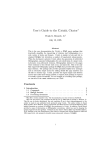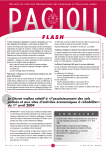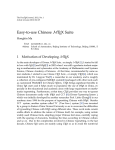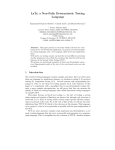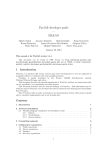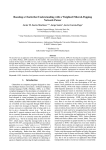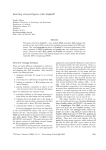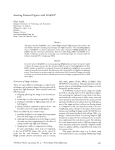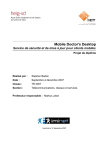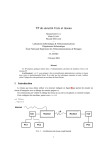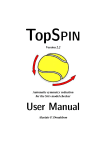Download Toward higher-order BibTeXing
Transcript
BTEX++: Toward Higher-order BTEXing Fabien Dagnat Computer Science Lab, ENST Bretagne CS 83818, F-29238 PLOUZANÉ CEDEX, France [email protected] http://perso-info.enst-bretagne.fr/~fdagnat/index.php Ronan Keryell Computer Science Lab, ENST Bretagne CS 83818, F-29238 PLOUZANÉ CEDEX, France [email protected] http://www.lit.enstb.org/~keryell Youssef Aoun, Laura Barrero Sastre, Emmanuel Donin de Rosière, Nicolas Torneri (Emmanuel.DoninDeRosiere|Nicolas.Torneri)@enst-bretagne.fr Abstract In the LATEX world, BTEX is a very widely used tool dealing with bibliographies. Unfortunately, this tool has not evolved for the last 10 years and even if a few other bibliographical tools exist, it seems interesting to develop a new tool with new features using modern programming standards. The BTEX++ project began in 1999 and is written in Java for the portability and object oriented aspects and offers new functionalities: for the expressiveness, the security model and native Unicode character set support, BTEX++ styles are directly Java classes; for compatibility, it uses advanced compiler techniques to translate plain old BTEX styles to new Java styles. Such a translated style can even set the development basis of a new native BTEX++ style to ease the style programmer’s life. The architecture is designed for extensibility and split into different components: core, parsers (to be compatible with other bibliographical styles, sources or encoding schemes), pretty printers (to generate bibliographies for other tools than LATEX), plugins. The plugin concept is used to dynamically extend BTEX++ functionalities. For example, since (meta-)plugins can load new plugins, new styles can be directly downloaded from the Internet. Résumé Dans le monde LATEX, BTEX est un outil répandu pour gérer les notices bibliographiques. Malheureusement, cet outil n’a pas évolué ces dix dernières années. Même si d’autres outils bibliographiques existent, il semble intéressant de développer un nouvel outil, offrant de nouvelles fonctionnalités et utilisant de nouveaux standards de programmation. Le projet BTEX ++ a démarré en 1999 et il est écrit en Java pour des raisons de portabilité et de fonctionnalités accrues dues aux aspects de programmation orientée objet. Il offre de nouvelles fonctionnalités : BTEX ++ est une classe Java, pour son expressivité, le modèle de sécurité et le support natif d’Unicode ; il contient un compilateur pour traduire les anciens styles BTEX en Java, et ce code Java peut être à la base d’un style bibliographique BTEX ++ natif de manière à faciliter la vie du programmeur ; l’architecture a été conçue en vue de l’extensibilité : le noyau, les parseurs (pour être compatible avec d’autres styles bibliographiques, d’autres sources ou codages), les enjoliveurs de code (pour générer des bibliographies pour d’autres outils que LATEX), les plug-ins ; le concept de plug-in est utilisé pour étendre BTEX ++ de manière dynamique. Ainsi, puisque les (meta-)plug-ins peut à leur tour charger d’autres plug-ins, des nouveaux styles peuvent être téléchargés sur Internet. Introduction A bibliography or list of references is a listing of all sources from which you have taken information directly 472 (by literal quotation) or indirectly (through paraphrase), or where you have used information or reproduced material. These references are used to: TUGboat, Volume 24 (2003), No. 3 — Proceedings of EuroTEX 2003 BTEX++: Toward Higher-order BTEXing • clearly identify each document. So it provides some identification elements to allow the reader to look for these documents in library catalogues or anywhere else. In most cases, these identification elements are normalized [17] (we often use the name of the book, the author, the editor, ...), but because of the digital revolution, there are more and more document types (web pages for example) and identification elements (e-mail, , ...). So the management of the references has become more and more difficult; • enable the reader to consult the sources you have used with a minimum of effort. Thus we have to indicate precisely where (on which page, the electronic location) or under which circumstances (personal interview, e-mail) you obtained the information. Unfortunately, creating a bibliography has always been a headache for typographers: if the article talks about “Larousse (2002)” as a book introducing metamiddleware [20] and in the bibliography “Larousse 2002” is described instead as a French cookbook, there has clearly been a problem somewhere. Another problem is that each journal has its own bibliography style, so bibliographical management software has to allow the user to create his own style and send it to other people. Fortunately, BTEX [23] is a popular tool used by the LATEX [21] community to generate bibliographical notices in publications. If there are also many other tools available [9], this one suits very well the LATEX philosophy and is well integrated with it: the user describes what she wants with a mark-up language without having to dive into the deep layout details: the LATEX infrastructure will use some styles to typeset the presentation from the high level content description. The citation matter is stored in a database (a file with a .bib extension) and BTEX picks from the .aux file the needed information according to the citation marks placed in the LATEX document (.tex file) by the author. A typeset version of the bibliography is made by BTEX to the .bbl file by using a .bst bibliography style file. The work-flow is summed up in figure 1 [13]. There are a lot of bibliographical styles available for BTEX targeted at many different scientific journals, book styles, etc. The user needs only to select the desired style and the bibliography notice is generated from her common bibliographical reference database. There are also a lot of such bibliographical reference databases available on the Internet that can be used directly, such as [22]. There are many tools targeted at easing the management of all these BTEX files: database tools, editors, ... For example to write this article we used the grand Emacs multi-platform text editor that has various .tex LaTeX .dvi .bib .aux .bst BibTeX .tex .bbl .blg LaTeX .dvi F. 1: BTEX work flow. modes to deal with a LATEX document in various coding systems: the great TEX mode [1] to deal with many things in the LATEX source file, refTEX [7] to deal with citations and cross-referencing, such as a bibliography browse-and-pick mode, and some BTEX editing modes. A lot of BTEX record databases are also widely available on the Internet through bibliographical servers such as CiteSeer [22] and it is often easy to get some BTEX records from few keywords. Even though there is so much material available for BTEX, BTEX is old, does not evolve anymore and has many shortcomings according to modern tool standards: the character encoding is constrained to an 8-bit variant, it is difficult to mix different languages on the database side or on the document side, memory usage is selected at compile time, style programming is done in a language that is rather optimized for the implementation efficiency and not for the style programmer’s brain. The tool lacks extensibility and such modern features as network awareness. This is why we began the BTEX++ project in 1999 as a way to extend the BTEX functionalities without throwing away the BTEX compatibility, databases and styles. In this article we present first the basic functionalities in BTEX++ (§ ‘BTEX++ functionalities’), then the software architecture in § ‘Software architecture of BTEX++’ with some emphasis on our ir compiler (§ ‘Software architecture of the ir to J compiler’) and the plugin architecture (§ ‘Plugins and metaplugins’). BTEX++ functionalities The BTEX++ name has been chosen to assert a BTEX compatibility with an improvement comparable to the object-oriented add-on from the C to C++ languages. The ordinary BTEX++ user does not have to embrace the object oriented architecture of BTEX++, but this is not the case for the style programmer (and of course the BTEX++ programmers). TUGboat, Volume 24 (2003), No. 3 — Proceedings of EuroTEX 2003 473 Fabien Dagnat, Ronan Keryell and Youssef Aoun, Laura Barrero Sastre, Emmanuel Donin de Rosière, Nicolas Torneri BTEX compatibility Since BTEX is a very widely used tool, compatibility with the old BTEX is a requirement. BTEX usage is simple; the first thing to do is to create the database file (a file with a .bib extension) or better to use an old one with at least the bibliographical references that are used in the article being produced with LATEX. Each reference record has a type chosen from the 13 possible default types (article, book, conference, thesis, ...) and is composed from various fields such as its key (used to cite this reference from the LATEX file), its title, its author(s), the publication year and so on such as: @BOOK{LaTeX:companion, Author = {Michel Goossens and Frank Mittelbach and Alexander Samarin}, Publisher = {Addison-Wesley}, Title = {The \LaTeX{} Companion}, Year = 1994 } This reference describes a book and can be cited with the key LaTeX:companion. If there are several authors, they are separated by an and. Plain LATEX can often be put in most of the fields such as the \LaTeX{} in the previous Title. There are numerous kinds of fields (23) available to be used to define a reference. According to the reference type, a field can be mandatory or optional. Other fields can be used for extensions or information since they will be ignored by BTEX itself. Once the reference file is created, the reference must be inserted in the LATEX document. For this purpose a \cite{hkeyi} command is put where a reference to hkeyi is to be cited. Thus with the previous example inserting in the text “\cite{LaTeX:companion}” will appear as “[13]”. One instructs LATEX to use a bibliography hstylei with \bibliographystyle{hstylei} and to insert the bibliography somewhere in the document from the database hbib-basei.bib with a \bibliography{hbib-basei} When run, BTEX picks in the hdocumenti.aux file the needed information given by the citation marks placed in the LATEX document (hdocumenti.tex file) by the author. A ready-to-typeset version of the bibliography is made by BTEX to the hdocumenti.bbl file by using a hstylei.bst bibliography style file and the citation matter found in the .bib file(s). Error and information output goes to the hdocumenti.blg file. The work-flow is summed up in figure 1 [13]. BTEX comes with some predefined styles but it is also possible to program other styles, for example to accept a url field to cite Internet information. All these styles are defined in .bst files that are used by BTEX 474 FUNCTION {sort.format.names} { ’s := #1 ’nameptr := "" s num.names$ ’numnames := numnames ’namesleft := { namesleft #0 > } { nameptr #1 > { " " * } ’skip$ if$ s nameptr "{vv{ } }{ll{ }}{ ff{ }}{ jj{ }}" format.name$ ’t := nameptr numnames = t "others" = and { "et al" * } { t sortify * } if$ nameptr #1 + ’nameptr := namesleft #1 - ’namesleft := } while$ } F. 2: sample code. to generate the bibliography according to the work flow described in figure 1. From the user point of view, these concepts are also used in BTEX++ texto with all the old BTEX styles available too. The style files are written in the language.1 This is indeed an awful stack-based language rooted in the sixties that was chosen for an easy implementation of BTEX concepts: it is simple to parse and to execute on a computer. The dark side is that the programming burden is put afterwards on the style programmer. code looks like that in figure 2 and there are 1258 such lines in the classical alpha.bst... It is clear that building a new style from scratch is a tour de force and often basic programmers will change only few details. Fortunately there are many styles available already that can fit most needs, and there are also some custom style generators [5]. Extensions to BTEX A basic extension is to be able to deal with encodings other than plain and more generally to be multilingual. Since BTEX can sort the bibliography, a localized sort according to the document language is to be introduced. 1. According to its author, this language has no name in fact. But for the clearness of this article we call it “”. TUGboat, Volume 24 (2003), No. 3 — Proceedings of EuroTEX 2003 BTEX++: Toward Higher-order BTEXing A tool designed today could hardly escape the networked world, so BTEX++ must have a way to access world-wide on-line bibliographical databases through the Internet. The language in BTEX lacks some expressiveness and a new language should be designed instead of trying to extend the old one. Some modern features should be added to allow scalability and extensions, for example by using an object oriented language. But we also want compatibility with the old BTEX styles that are written in , so this is rather tricky. Besides, BTEX targets only LATEX; BTEX++ could also target other typesetting tools or other bibliographical database concepts. But since BTEX++ is still a work in progress as a general bibliographical workbench, there are many new functionalities that are not yet implemented or even not envisioned yet. Style programming in BTEX++ If we have to define a new language for BTEX++ it should be a clearer language than . A good candidate is to choose a domain specific language (). From a programmer point of view it is yet another (less) cryptic language to learn that is still cumbersome. The expressiveness may not suit everyone’s needs, and we may extend the language later to fit some usages. On the other side, if we want a language as expressive as any another computer language, why not use such a language? If we choose an object oriented language, all the domain specific aspects could be seamlessly hidden in objects dealing with all the bibliographical stuff. Since in BTEX++ there is no particular performance requirement, this solution is acceptable. The next question is to select an implementation language. We want BTEX++ to be portable, programmed in a clean language from a syntax and object point of view that can deal with big programs. The language should come with a lot of standard libraries to deal with all the modern programming ways (Unicode, Internet, ...), and widespread enough to avoid the yet another weird-language to learn syndrome. Of course there is no one-stop answer and we cannot escape some trade-offs. From our point of view, J has been considered as a good candidate. The BTEX++ core is thus directly written in J for expressiveness and simplicity. All the generic library functions and classes to deal with bibliographies in BTEX++ have been rewritten in J too. BTEX++ can run on every machine for which we have a run-time and a compiler. For internationalization, Unicode is natively accepted in J, we inherit all the J locale stuff and even specialized collators for international sorting so important in BTEX. Of course choosing a language different than the original language does not solve at all the BTEX compatibility issue. This one can be solved by implementing BTEX as an add-on in BTEX++, which would remove a lot of interest in BTEX++, or add a translation process from to the new programming style in BTEX++. This last approach is more challenging but far more interesting since the translated old styles can be used as the basis of new style developments. This translation process is more deeply described in § ‘Software architecture of the ir to J compiler’. Extending BTEX++ further: plug-ins and meta-plug-ins Extensions in the old BTEX to deal with new concepts are quite difficult to develop since code must be added directly in the BTEX source. In a modern tool, it is mandatory to use a more incremental and tractable approach even for an inexperienced user by allowing loadable add-ons or plugins instead of needing to dig into the code to change its behavior. A plugin is a piece of code (a module) that can be added to BTEX++ to increase its functionality without having to change the native BTEX++ infrastructure. Plugins should be able to modify any BTEX++ behavior without corrupting the original design. Of course there is compromise to be found between expressiveness and complexity. We present further the kind of extension one can expect with the plugin concept applied to different parts of BTEX++ (described later in § ‘Overview of the BTEX++ architecture’). Parsers A natural extension needs to regard the input syntax that BTEX++ can accept. New parsers can be written and used to change any information source into some internal abstract representations of the tool. The bibliographical source could be changed to directly use the CiteSeer database [22] through the Internet, use some database or any other bibliographical database tool instead or in addition to the old .bib syntax database. The input selection, normally read from the .aux file to pick \cite information, could be extended to deal with OpenOffice, DB or Word documents. Prettyprinters Since BTEX++ can be seen as a parameterized compiler that deals with some internal bibliographical representations, it could be nice to target other output formats than LATEX such as an OpenOffice, DB or Word document syntax or to automatically internationalize a style from one language to another. TUGboat, Volume 24 (2003), No. 3 — Proceedings of EuroTEX 2003 475 Fabien Dagnat, Ronan Keryell and Youssef Aoun, Laura Barrero Sastre, Emmanuel Donin de Rosière, Nicolas Torneri In an easier way, BTEX++ could be used to translate a .bib file to another bibliography database format or apply some basic manipulations on bibliographical databases (sorting, merging, ...). Style transformation More generally, adding some features to already existing styles is useful to revive some of the old-fashioned styles; for instance, adding new url records to old styles written before the Internet wave. To make a bibliographical database or a researcher publication list [19] available on the Internet it could be useful to be able to fetch, close to the typeset bibliographical notice, the .bib record itself that was used to generate the notice if someone wants to cite it in her article. This could be done in any style by using an appropriate plugin. Metaplugins Whereas BTEX did not evolve for many years, BTEX++ should rapidly evolve according present programming and Internet standards. A natural way is to use mobile code concepts in BTEX++, code that can also be downloaded by a plugin itself. Since it is a plugin that can fetch from the network other plugins it has been nicknamed ‘meta-plugin’ in BTEX++. One can embrace various future uses of this concept. First, to write this paper we could have picked all the BTEX++ bibliographical style from the TUGboat web site. On the BTEX++ web site we could have a page referencing all the bibliographical databases available on the Internet. A plugin associated with this page could download other plugins to deal with each database we are interested in. If a new typesetting tool is introduced, its author could provide on her site some plugin material for BTEX++ to be compatible with that new tool. The BTEX++ user would only provide to the meta-plugin the plugin address. We will see in § ‘Security model’ how to circumvent the obvious security issues related to this kind of mobile code in the wild. Plugin syntax To remain close to the existing LATEX and BTEX interaction syntax we do not add new LATEX macros but rely on the current ones, merely adding special keywords inside the \bibliography and \bibliographystyle macros. Of course plugins can also be included from the BTEX++ invocation line or with another mechanism to suit other input formats than LATEX. To avoid conflicts with other tools that could also use this kind of extensions, a naming space beginning with :bibtexpp is used. For example if a user from the computer science community wants to directly use citations from the CiteSeer database [22], this will be chosen with \bibliography{:bibtexpp:plugin:citeseer} 476 If a user wants to add a plugin style to automatically add the output of a url attribute if any from the database at the end of the typeset bibliography item, the following will have to be added \bibliographystyle{:bibtexpp:plugin: add-attribute:url} or more generally to add the output of some specific attributes description and summary \bibliographystyle{:bibtexpp:plugin: add-attribute:list:description,summary} or all the attributes with \bibliographystyle{:bibtexpp:plugin: add-attribute:all} Plugins themselves can be downloaded from the default BTEX++ network repository defined in its code with, for example \bibliographystyle{:bibtexpp:plugin:meta: beautiful-bib} of from any other place by defining a such as \bibliographystyle{:bibtexpp:plugin:meta: URI:http://nice.bib.org/beautiful-bib} If the BTEX++ installation is a little bit old, some plugins may be absent from the local distribution but present in the BTEX++ Internet repository. To be able to compile documents without choking, BTEX++ can be used in an automatic metaplugin way where any lacking plugin will be retrieved from the repository. If other plugins have been registered on the naming global BTEX++ directory but reside on other servers, a proxy-plugin will be downloaded to download later the real plugin code from its server. Naming clashes should be avoided either with the current LATEX best practice for package names or by using a hierarchical naming space mimicking Java class naming space or names. Indeed a plugin call can be defined equally well in either the \bibliography or \bibliographystyle macros, but according to the plugin role, one may be more logical than the other. The basic compatibility with LATEX and BTEX is based on the fact that some macros with this syntax will only generate warning in BTEX without stopping the LATEX compilation. Of course, the bibliography of the document will be lacking or at least incorrect, a user without BTEX++ will be able to have an approximation of the document. More expressiveness can be used with new macros, defined in a new package bibtexpp, if this compatibility is not mandatory. Of course, a parser plugin can itself define a new plugin definition or parameter syntax to deal with other TUGboat, Volume 24 (2003), No. 3 — Proceedings of EuroTEX 2003 BTEX++: Toward Higher-order BTEXing ... .tex LaTeX .dvi .db .aux .bib .xml ... .bst Bibliography Style front−end front−end Document BibTeX++ Back−end front−end core pretty−printer .doc .tex .db .bbl .doc .blg LaTeX .dvi F. 3: BTEX++ work-flow. input languages such as with DB or Word documents. Software architecture of BTEX++ Overview of the BTEX++ architecture In BTEX++ we are specially interested in the software architecture point of view since the project began first with the challenging idea of compiling the language into something newer and more expressive. The principal elements of this architecture are closely related to the BTEX++ data-flow, and are summed up in figure 3. To be more generic and more scalable, output is handled by prettyprinters of internal representations, and input is read by parsers that build a common internal representation. In this way, we have only to define a new prettyprinter or parser to deal with a new format, without having to change the BTEX++ internals. The parsers are made with Sable [12], a compiler compiler for J written in J. Unlike other compiler compilers (such as J Cup, for example [14]), we do not need a specific library to use the generated compiler. So users only need J to execute BTEX++. • The parser which tries to obtain the name of the style, database filenames, and information about languages used in the LATEX file. • The parser which converts databases to a list of J objects. • The parser which transforms a style file into a syntax tree. • The compiler. It takes this syntax tree and makes a J style file from it. It also tries to correct some common errors in files and optimize the output code. BTEX++ core The core deals with all the basic BTEX++ infrastructure, from bibliographical concepts to house-keeping and the data structures used by various abstract internal representations. All the BTEX functionalities that can be used by the various bibliographical style are implemented in a core library. Bibliography back-end This relatively simple part outputs the internal style execution into a file usable by the typesetting tool to be used. Right now, a .bbl file to be used by LATEX is generated but by changing this prettyprinter other output could be generated for another tool. Document front-end It is organized according to a strategy pattern to be able to deal with various document formats. Right now a Sable parser has been written to deal with LATEX only. Bibliographical database front-end This front-end also follows a strategy pattern to cope with various database formats. A Sable parser has been written now to read only BTEX bibliographical database in the .bib format. Caching BTEX++ styles BTEX++ styles can be stored on the computer running it, as with BTEX, but can also be retrieved from the network or translated from an old BTEX style. If the first access method is quite fast, the two other ways may be deadly slow compared to it. This is why a cache architecture has been added in the BTEX++ style pipe to avoid fetching again and again a remote BTEX++ style or translating a style from BTEX format on every BTEX++ run. Software architecture of the ir to J compiler Now we consider the ir compiler for translating to J. See figure 4. The BTEX stack-based input language BTEX++ .bst files use a stack-based language: it is a type of lan- TUGboat, Volume 24 (2003), No. 3 — Proceedings of EuroTEX 2003 477 Fabien Dagnat, Ronan Keryell and Youssef Aoun, Laura Barrero Sastre, Emmanuel Donin de Rosière, Nicolas Torneri .bst bst compiler .java Java compiler .class Cache Core F. 4: Compilation work-flow. guage where you push the data to manipulate on a stack. Also, functions store their results on this stack. The syntax uses a reverse polish notation (also called postfix notation). For example, to compute 2 + 3, you first push 2 and 3 on the stack and then call the add operator, so you have to write something like this: 2 3 +. Some stack-based languages We may cite as stackbased programming languages: • Forth, used in many fields, especially embedded control applications; • PostScript, used primarily in typesetting and other display purposes. Because the majority of PostScript code is written by programs, it can also be regarded as an intermediate language; • (reverse polish ), the language of the -48 calculator. It is a run-time type-checked language with mathematical data types (it is on a calculator) and has a Forth-like syntax; • the BTEX style () language, the stack-based language used for processing BTEX databases. Although stack-based languages are sometimes used as programming languages, they are more popular as intermediate languages for compilers and as machineindependent executable program representations. As intermediate languages may be listed: • the -code used in the system, an operating system well-known for its Pascal compiler. code was either interpreted or compiled to native code. We can find today -code compilers for more recent systems; • the Smalltalk-80 bytecode is the intermediate language of the Smalltalk-80 system. Some other stack-based languages target several machines as machine-independent languages, notably: • the J bytecode output from compiling a J file. It can be used on every system supported by J because it will be interpreted by the (J Virtual Machine). 478 Unfortunately computers are mainly register machines2 and it is not easy to implement directly and efficiently a stack-based language. That is another reason why stack-based languages are not frequently used. Today, there are 3 ways to execute a stack-based language on register machines, via: • an interpreter. The execution is dynamic but very slow; • a compiler that statically transforms the code into target one; • a source-to-source translator to convert stack-based code into a high-level language that is then compiled for the target. It allows the code to be executed on many different systems if the high-level language is well-known and widely used. language A style file for BTEX is a program that formats the reference list in a certain way. For example, a style file can sort the reference list in alphabetical order using the author names, and italicize titles. The language [23] is a domain-specific language using ten commands to manipulate language objects (constants, variables, functions, the stack and the entry reference list). A string constant is between double-quotes like "abcd efgh" and an integer constant is preceded by an # like #23. There are also three different types of variables: • global variables, declared by INTEGERS or STRINGS commands; • entry variables, which can be strings or integers, with a value assigned for each entry of the list; • fields, which are read-only strings. They represent information from the curent reference item, so each one has a value for every entry. Among the 10 commands available, here are some of the more interesting ones: • ENTRY declares the fields (in the bibliography databases) and the entry variables. crossref is a field which is automatically declared (used for cross referencing) and sort.key$ is an entry variable (used for sorting references), also automatically declared; • ITERATE executes a single function for each entry in the reference list. These calls are made in the list’s current order; • READ reads the database file and assigns to fields their value for each entry; • REVERSE performs the same action as ITERATE but in reverse order; • SORT sorts the reference list in alphabetical order according to sort.key$. 2. There is probably no other popular architecture since the Transputer [16]. TUGboat, Volume 24 (2003), No. 3 — Proceedings of EuroTEX 2003 BTEX++: Toward Higher-order BTEXing C variables All these commands support defining the structure of a style file. But with them, we can not manipulate variables. This is why 37 built-in functions have been declared in BTEX, from integer and string computations to control-flow operation (if$, while$, ...) and the write$ which writes the top string item into the .bbl file (the BTEX output). With all these built-in functions and commands some other new useful and more complex functions can be designed such as: FUNCTION {and} { ’skip$ { pop$ #0 } if$ } This function calculates the “logical and” between two numbers: if the first element on the stack is greater than 0 (meaning “true”), skip$ is executed so this function returns the second element on the stack. Else, pop$ #0 is executed which puts 0 on the stack. We can see that, even with this over-simplified example, it is not very easy to understand the language: • we are not accustomed to postfix stack notation; • the number and the type of input and output variables are implicit; • we have to read all the control structure in reverse order. This explains why only a few people are able to program a new style in this language. So for BTEX++, we will have to create a more expressive style language. But because of the need for compatiblity with BTEX, we’ll have to transform this stack-based language into a standard one. So we will see how to remove the stack in a stack-based language. Stack removing in stack-based languages A number of techniques have been proposed in the literature for this type of translation. Source-to-source translator There are only a few source to source translators for stack-based language. The most famous research on this was done in [10, 11] where Forth code was translated into C in order to increase the portability of Forth applications. Ideally, to use a Forth application on a special system, one should develop a special interpreter. However, if one transforms the Forth into C first, the program can be used on every system where a C compiler is available. Furthermore, no deep optimization of the translator is needed since the C compiler will optimize the output code. Practically all the other source to source translators for stack-based language are J decompilers like krakatoa [24] or mocha [25] which try to transform J bytecode back into J. With this, the idea is to get back the program sources from compiled files. Nevertheless, all these translators use the same algorithm and special x1 x0 p0 p1 p2 Stack տ Top of the stack տ Top of the stack upon function entry F. 5: Stack mapping to C variables. optimizations for J and (J Virtual Machine) bytecode. In [11] the f2c Forth to C translator described uses several steps to convert Forth code to C language. The first is to split the code into its functions which will be processed independently. Then, f2c counts the number of input and output parameters for each function. The next step is to convert the elements on the stack into C’s local variables, as shown in figure 5. In that figure, p0 , p1 , . . . represent the entry variables of each function and x0 , x1 , . . . are used like local variables. This scheme ensures that stack items that are not affected by an operation do not have to be copied around between local variables. Then f2c converts each Forth primitive into a C sequence. For example, if the top of the stack resides in x1 , the translation of + will look like: { Cell n1=x1; Cell n2=x0; Cell n; n = n1+n2; x0=n; } /* top of the stack now: x0 */ This sequence is very long, but a good C compiler can compile it to only one instruction (sometimes, it can convert several sequences into one instruction). So the translation process always works like this: • all the useful elements are declared as C local variables and are initialized; • the C code for the Forth primitive is generated; • the result variables are copied back to the stack. f2c has also to convert all the control structures. Since Forth allows the creation of arbitrary control structures, it is easiest to convert them into C goto instructions and labels. This translation mechanism must know the height of the stack everywhere in the Forth code, but it is not always possible. Sometimes the stack depth is unknown. For example, the instruction ?DUP 0= IF means that if the top of the stack is 0, replace it with the previous element on the stack, else we delete the element. So in this TUGboat, Volume 24 (2003), No. 3 — Proceedings of EuroTEX 2003 479 Fabien Dagnat, Ronan Keryell and Youssef Aoun, Laura Barrero Sastre, Emmanuel Donin de Rosière, Nicolas Torneri case, f2c has to create a stack in C and use it throughout the whole function. Compiler Source-to-source translators are not the only software which remove the stack in a stack-based language. Stack-based compilers do the same thing, but they convert this language into a low level one (often into mnemonic instructions). So their algorithms may be useful for BTEX++. [10] is a framework for compiling Forth code. It tries to produce fast and efficient code, so it needs to use some optimization techniques and interprocedural register allocation to eliminate nearly all stack accesses because they slow down the execution of the program. compiles all of Forth, including unknown stack heights. uses several steps to compile Forth code. The first step is to split the code into basic blocks. A basic block is a set of instructions which contains only simple primitives like literals, constants, variables, operators and stack manipulation instructions. So a basic block does not contain any branch or jump: all primitives are executed sequentially. Then builds a data flow graph of this basic block. After that, it converts the Forth primitives into mnemonic instructions and transforms all stack items into unlimited pseudo-registers. So all stack accesses within a basic block have been eliminated and the (Directed Acyclic Graph) is now an instruction . Then an instruction scheduler orders the nodes of the instruction , i.e., it transforms the into a list. This list is optimized to reduce register dependencies between instructions. Now, we have a set of mnemonic blocks, but we have to connect them with control structures. Control flow splits (IF, WHILE and UNTIL) are easy to transform but control flow joins (ENDIF and BEGIN) are a little harder because the corresponding stack items of the joining basic blocks usually do not reside in the same register. So needs to move some values around to have the same structure. In order to have faster output code, three good register allocation algorithms are proposed: graph coloring register allocation [2], hierarchical graph coloring [3], and interprocedural allocators [4]. Another stack elimination in a compiler can be found in J compilers. Today, faster and faster execution is needed for J applications. Better J performance can be achieved by Just-In-Time () compilers which translate the stack-based bytecode into register-based machine code. One crucial problem in J compilation is how to map and allocate stack entries and local variables into registers efficiently and quickly so as to improve the J performance. LaTTe [28] is a J compiler that performs 480 fast and efficient register mapping and allocation for machines. LaTTe converts J bytecode (a stack-based language) to assembler. It uses severals steps for this: • first, LaTTe identifies all control join points and subroutines in the J bytecode, via a depth-first traversal, in order to build a control flow graph (); • then, it converts this bytecode into a of pseudo instructions with symbolic registers; • optionally, some traditional optimizations are performed; • in the fourth step, LaTTe performs a fast register allocation, generating a of real instructions. • finally, the graph is converted into a list of instructions. To transform the stack into registers, LaTTe uses symbolic pseudo- registers whose names are composed of three parts: • the first character indicates the type: a for an address (or object reference), i for an integer, f for a float, l for a long and d for a double; • the second character indicates the location: s for operand stack, l for local variable and t for temporary variables used by LaTTe ; • the remaining number distinguishes the symbolic registers. For example, il2 represents the second local integer register. At the end of the algorithm, LaTTe transforms these pseudo-registers into real ones with two passes for each extended basic block: • the backward sweep algorithm is a post-order traversal which collects information on the preferred destination registers for instructions; • the forward sweep algorithm is a depth-first traversal which performs the real register allocation using that information. Sometimes, we need to move some registers in order to reconcile register allocation at region join points because LaTTe uses these two algorithms on each extended basic block independently. So two blocks may not use the same register for the same item on the stack. Globally, this method is very efficient: the output code of LaTTe is on average two times faster than the S , and this speed comes particularly from the register allocation algorithm. Compiling BTEX styles to BTEX++ J styles The transformation of a typeless stack-based language into an object-based one is something quite unusual, and a bit complex. We planned a classical compiler architecture divided into several steps as shown in figure 6: TUGboat, Volume 24 (2003), No. 3 — Proceedings of EuroTEX 2003 BTEX++: Toward Higher-order BTEXing Parser Lexer bst AST Tree Translator JAVA AST JAVA JAVA Optimizer Optimized AST Pretty Printer .java .bst F. 6: ir architecture. • first, we use the parser to convert a file into a abstract syntax tree () with a Sable grammar; • then, in the tree translator the is transformed to a J-like : – useful information from the tree is gathered, like function names, global variables, ... Functions are analyzed to decide if the stack can be removed and if so what is the number of inputoutput parameters; – unlike , J is a type-based language, so we need to know the type of every variable in the non-stack-based session. But in some cases, it is very difficult to find this type, so if we cannot determine it, we use instead a Cell object: an object that can store both an integer and a string; – with this data, the is translated into a J ; • later, the J tree is optimized with some classical transformations such as constant propagation, dependencies reduction, transformation of integer into boolean in the condition block, dead code elimination, peephole optimizations, ...; • at last, a J file is written by the prettyprinter and the new J BTEX++ style can be compiled and used. Globally, some code like FUNCTION {or} { { pop$ #1 } ’skip$ if$ } will be converted into J as public int or( int i0 , int i1 ) { if( i1 > 0 ) { i0 = 1; } return( i0 ); } For most users and style designers, since the second block of code has been optimized for human comprehension, it should be easier to modify an existing style as a development basis of a new native BTEX++ style. Furthermore, because there are more J programmers than ones, new arbitrary and complex styles will be easier to create with BTEX++ than with BTEX. If a simple interpreter had been designed instead of a translator, this would not have been possible. More information on the to J compilation can be found in [8] but 2 phases are detailed here. J translation First, information about functions is searched for in the . For each function, we try to obtain the name of the function, the number of input and output parameters and the possibility of removing the stack in this function (unfortunately this is not always possible). Then the type of the arguments of all functions are inferred with type propagation from hints found in the program outside the stack, such as typed constants (a string or an integer), typed global variables, and use of BTEX functions with well-known entry or return types. The propagation is recursively done for all the home-made functions. Propagation is done in both directions in a use-def or def-use way to deal with typed entries or output. Some further abstractions are used to follow the dependency graph even if there are stack manipulation operations in the code such as duplicate$, pop$ or swap$. When it is not possible to infer the type, it indicates that we will have to use a polymorphic Cell object which can store either a string or an integer. Next the body of the functions and their stacks are analyzed to determine how many J local variables we will have to use, and their types. With all this information, the code is translated to J functions where we can remove the stack by using local variables instead of stack items when possible, or generate J functions with a J stack when stack removal is not possible. Variables are named accordingly to figure 7. If the type has been inferred, the native J types String or int are used instead of our polymorphic type Cell. If stack removal is not possible in a given function, the stack architecture is kept, but with a J . The generated code looks like this: public void format_bdate() { stack.push(year); stack.push(BuiltIn.empty( stack.pop().getString())); if( stack.pop().getInt() > 0) { stack.push("there’s no year in "); stack.push(BuiltIn.cite( bib )); stack.push(stack.pop().getString() TUGboat, Volume 24 (2003), No. 3 — Proceedings of EuroTEX 2003 481 Fabien Dagnat, Ronan Keryell and Youssef Aoun, Laura Barrero Sastre, Emmanuel Donin de Rosière, Nicolas Torneri JAVA local variables s0 = "cited "; s1 = lastchecked; s0 = s0 + s1; Stack c5 | i5 | s5 c4 | i4 | s4 } return( s0 ); Top of the stack c3 | i3 | s3 Number of input parameters c2 | i2 | s2 c1 | i1 | s1 } Top of the stack upon function entry c0 | i0 | s0 Deepest element in the function F. 7: Variable notations in ir. +stack.pop().getString()); System.err.println("Warning : " +stack.pop() .getString() +"."); } else { stack.push(year); } } If a function with a stack is called by another function, the latter will have a stack too. Calls to any of the 37 built-in functions of BTEX are translated to direct J code when possible (such as for +) or to calls to equivalent functions in the BTEX++ library. For example, the translation of this function: FUNCTION {format.lastchecked} { lastchecked empty$ { "" } { inbrackets "cited " lastchecked * } if$ } will be (without optimizations) public String format_lastchecked( ) { String s0 , s1; int i0; s0 = lastchecked; i0 = BuiltIn.empty( s0 ); if( i0 > 0 ) { s0 = ""; } else { inbrackets( ); 482 We can see the call to the empty function and the translation of the * concatenation operator to the + J concatenation. The control flow operators if$ and while$ are replaced by their J counterparts. After these four passes, we have a J but this code is not optimized at all, so we need to clarify it a little. J optimization We decided to use several types of independent optimizations in order to provide a final optimization which is fully customizable by the user. We do not need very complex optimizations, because the aim of this is to increase legibility, rather than speed execution. Another reason for using simple optimizations is that the input code was written by human programmers in a not very understandable language, so they tried to write this code cleanly. We use eight different functions for this: • an if optimizer simply removes all the empty then or else blocks found in a plain code; • a copy and constant propagation function removes most of the variables generated, instead of stack usage. This increases the quality of the next phase, dead code elimination; • a dead code elimination function is associated with the propagation optimization to remove many useless definitions, because it deletes all write after write dependencies; • a boolean translator: since in the language there is no boolean type, this optimization tries to transform integer to boolean in if and while conditions. For example, it will transform if( BuiltIn.equal( i1 , i2 ) > 0 ) to if( i1 == i2 ); • other small optimizations such as peep-hole optimization and poor-man partial evaluation: for example, transforming a1=a0+0; into a1=a0; or "some"+"thing" into "something", and so on. These optimizations only try to increase the readability of the J code. After these optimizations we get somewhat cleaner code, such as this from a previous example: public String format_lastchecked( ) { String s0; if( BuiltIn.empty( lastchecked ) > 0 ) { TUGboat, Volume 24 (2003), No. 3 — Proceedings of EuroTEX 2003 BTEX++: Toward Higher-order BTEXing s0 = ""; } else { inbrackets( ); s0 = "cited " + lastchecked; } return( s0 ); } If we look at another function from plain.bst: FUNCTION {new.sentence} { output.state after.block = ’skip$ { output.state before.all = ’skip$ { after.sentence ’output.state := } if$ } if$ } This is translated to rather long J code: public void new_sentence( ) { int i0 , i1; i0 = output_state; i1 = after_block; i0 = BuiltIn.equal( i1 , i0 ); if( i0 > 0 ) { } else { i0 = output_state; i1 = before_all; i0 = BuiltIn.equal( i1 , i0 ); if( i0 > 0 ) { } else { i0 = after_sentence; output_state = i0; } } } but the optimizations downsize it to a more understandable function: public void new_sentence( ) { if( output_state != after_block ) { if( output_state != before_all ) { output_state = after_sentence; } } } We can see in this example many different optimizations at work: • all empty then blocks have been removed; • all global variables have been propagated: the code i0 = after_sentence; output_state = i0; has been transformed into output_state = after_sentence; We no longer use any local variables; • some built-in functions have been converted to boolean operators: the BuiltIn.equal( i1 , i0 ) > 0 is now a simple i1 > i0. So we can see here that all these transformations are pretty efficient. Indeed, the optimized function is much more readable that the non-optimized one. Plugins and meta-plugins Plugins architecture The strategy pattern used is based on hook mechanisms such as that used in the Emacs editor. In the original design, many hook points are chosen to enable users to insert calls to their own functions. From a software engineering point of view, it is close to aspect programming, but in a restrictive way since all the points that can be modified are defined in advance. We think this approach is more tractable but if some features are not easy to implement with the existing hooks, more can be added since BTEX++ is also an evolving open source program. Lots of hook objects can be used to replace objects in the current architecture, thus modifying the global behavior, as in the following examples. Some other specialization frameworks remain to be studied further in this context to fit future extensions, such as direct subclassing of BTEX++ classes, aspect programming, and reflection and introspection on BTEX++ classes. The main issue is that code complexity remains manageable and security is not endangered. Parsers The management of the various inputs is dealt with by parsers crafted to each input format. They rely heavily on the Sable parser generator [12] to speed up retargeting of BTEX++ to a new data format. New parsers can be loaded as plugins in BTEX++ when requested by the user. Prettyprinters Writing plugins to output new .bib database files does not cause any trouble since it is a simple prettyprinter that outputs the internal database representation. But automatically translating the BTEX++ output into another language or targeting a new typesetting system is far more challenging. Basically, BTEX++ is a tool able to run BTEX++ native code or BTEX code in TUGboat, Volume 24 (2003), No. 3 — Proceedings of EuroTEX 2003 483 Fabien Dagnat, Ronan Keryell and Youssef Aoun, Laura Barrero Sastre, Emmanuel Donin de Rosière, Nicolas Torneri an improved way, but is not able to abstract the semantics of what a piece of BTEX code itself really does (of course; in fact, this is an intractable issue from theoretical computer science). BTEX++ has no idea that it is outputting an author name or a conference name: it is executing a J procedure with a side effect that outputs a string. Thus, we can only rely on some heuristics to deal with the prettyprinter parameterization, such as recognizing a .bib text output and translating it. Since it is not possible to understand the BTEX++ style it is not possible to modify it for retargeting the LATEX output to another typesetting format. Instead, one can translate the LATEX output item to another format. This is simple to do since generally bibliography styles do not generate complex TEX programs, but only text with some simple LATEX mark-up tags. On the other hand, the key information, being directly managed by BTEX and BTEX++, can be dealt with by the plugin and output in the correct format. Modifying the output of the bibliography style with a plugin is harder, since one should access the type of the data. For example if one wants to write a plugin to modify any existing style to display the dates in a numerical form instead of a textual one, say by replacing via regular expression mechanisms all occurrences of “November” with “11”, one needs to apply this translation process only on the date field which we are ... not aware of! And what would happen if an author is named “November”? This kind of problem is similar to automatic translation of buggy pre-year-2000 programs that cannot deal with years after 1999 to cleaner programs that can deal with them. Automatic transformations must be applied only on code that certainly deals with dates and not other numerical computations. An interesting approach could be to type the output text with the data attribute used to build this text through BTEX++, in order to approximate the data dependence graph with a slicing approach [26] (that is, to extract from the style code only the minimal code needed to generate the value of a given variable) statically during the BTEX compilation process or by statically analyzing the J BTEX++ style. In this way it could be easy to determine that a given part of the text is a textual representation of the year, the author names, or the title, and use this information to translate these texts in a representation without \bibitem and so on, suitable for other typesetting tools. The typeset output for LATEX could thus be retargeted easily since we would now have in the output what is an author name, what is a surname, what is a conference title, etc. Since we only want to know what input fields are involved on a given output field, we can use dynamic de484 pendence graph reconstruction. Since BTEX++ is programmed in an object oriented language, overloading of the data type class to embed this on-the-fly dependence graph construction could be easy. At the BTEX++ output procedure, for each character, the input fields used to compute its value is known. This is similar for example to the tainting concept of variables used in the Perl language for security reasons, to know if a variable value has been computed by using a value given by the user, or not. If yes, and that variable is used to execute a privileged operation, the programmer may refuse to execute such a dangerous thing by using tainted mode. The automatic internationalization process uses the same approach to translate the output text from one language to another. But if we have existing bibliography styles, say, for l languages and we want to be able to translate every language to any other, we need to write l(l−1) translators, which is cumbersome. Instead, if we introduce a kind of “esperanto” intermediate abstract representation, we only need to write l translators to this intermediate form and then l prettyprinters to each language. Another way for classical crude code translation would be to use pattern matching to translate common piece of code. Of course, since no semantics recognition can be used, this method is not very adaptable. Code transformation It is interesting to have a code transformation engine in BTEX++ to allow plugins to modify the behavior of other styles, and implement other features. Transformations could be done at different levels in BTEX++, on the internal representation or the J BTEX++ style more generally, or more conservatively on the input data structures. The code transformation itself could use the hook mechanisms already present in the code, or an aspect programming tier in the BTEX++ infrastructure. A low level approach could be to allow plugins to modify the code (for example, adding at the end of the output routine a call to a new procedure that will output a new field) by using J reflection and introspection. Of course, from the security point of view this should be very carefully controlled to avoid plugin malware rewriting security checking in BTEX++. But this can also be enforced by the underlying J security model, which we turn to now. Security model In a tool such as this, where code can be downloaded by foreign documents automatically and transparently from alien servers, security sounds a little scary. It could be easy to design BTEX++ viruses. Hopefully, BTEX++ is written in J, which implements a sensible security model controlling in a centralized way the execution of arbitrary code [18] at a TUGboat, Volume 24 (2003), No. 3 — Proceedings of EuroTEX 2003 BTEX++: Toward Higher-order BTEXing very fine level. We use this mechanism that has been tailored to allow secure execution of programs retrieved from the Internet (applets) in web browsers in a similar way. It is used in BTEX++ to avoid plugin code accessing sensitive local resources, modifying the security infrastructure of BTEX++, and other obvious concerns. At installation, the policy file contains grant { permission java.util.PropertyPermission "bib_max", "read,write"; }; grant codeBase "file:${bib_lib}" { permission java.io.FilePermission "<<ALL FILES>>", "read,write,execute"; permission java.util.PropertyPermission "bib_cache", "read"; permission java.util.PropertyPermission "bib_lib", "read"; permission java.util.PropertyPermission "java.class.path", "read"; }; All classes except those inside the BTEX++ library (thus, plugins and styles) can only access one environment variable: bib_max. It is the maximum length of a string in a style. Performance results With the power of modern computers compared with the older computers at the beginning of BTEX, we may think that compiling a bibliography must be quite fast and not significant in the composing time. But although the original BTEX is quite simple and fast, BTEX++ is noticeably more complex with its compiler engine and various optimization phases. One could ask if it is still fast enough. Some tests were made on a Athlon 2000+ with 512 of with j2re (Java 2 Runtime Environment) version 1.4.1 for L. The BTEX++ programs were compiled by the S javac with the -O option to optimize the code. Besides the performance evaluation, the compatibility of ir with BTEX styles has been investigated by compiling all 152 styles in the MiKTEX distribution. This allowed us to find and correct some bugs in our software, as well as some bugs in old BTEX styles. The execution time and the size of the styles between the optimized version of ir and BTEX++ and the normal one is compared in figure 8. We can see with the ir execution time that it is two times slower to generate optimized J style file than non-optimized one. Nevertheless, the compilation of a .bst style file to a J class file remains quite fast, by considering the 400 Seconds 375 304 300 187 200 297 ✟✟ ✟ ✟ ✟✟ ✟ ✟ ✟ ✟ ✟ ✟ ✟✟ ✟✟ ✟ ✟ ✟✟ ✟ ✟ ✟ ✟ ✟ ✟ ✟ ✟✟ ✟✟ ✟ ✟ ✟✟ ✟ ✟ ✟ ✟ ✟ ✟ ✟ ✟✟ ✟✟ ✟ ✟ ✟✟ ✟ ✟ ✟ ✟ ✟ ✟✟✟ ✟✟ ✟✟ ✟ ✟ ✟ ✟ ✟✟ ✟ ✟ ✟ ✟ ✟✟ ✟✟ 100 ✟ ✟ ✟✟ ✟✟ ✟ ✟ ✟ ✟ ✟ ✟✟✟ ✟ 0 ✟✟✟ javac compilation BiSTrO execution ✟✟ ✟ ✟ Without the -O option ✟✟ 129 133 ✟✟ ✟ ✟ ✟✟ ✟ ✟ ✟ ✟ ✟ ✟ ✟✟ ✟✟ ✟ ✟ ✟ ✟✟ ✟ ✟ ✟ ✟ Bibliography creation With the -O option F. 8: Total execution time of the BTEX++ components on 152 styles. 80 70 60 50 40 30 20 10 0 ko 68 ✟✟ ✟ ✟ ✟✟ ✟ ✟ ✟ ✟✟ ✟ ✟ ✟ ✟ ✟ ✟ ✟✟ ✟✟ ✟ ✟ ✟✟ ✟ ✟ ✟ ✟ ✟✟ ✟✟ ✟ ✟ ✟✟ ✟ ✟ ✟ ✟ ✟✟ ✟✟ ✟ ✟ ✟✟ ✟ ✟ ✟ ✟ ✟✟ ✟✟ ✟ ✟ ✟✟ ✟ ✟ ✟ ✟ ✟ ✟ ✟ ✟✟ ✟✟ ✟ ✟ ✟ ✟ ✟✟ .java file ✟✟ ✟ ✟ ✟✟ 53 32.2 ✟ ✟✟ ✟ ✟ ✟ ✟ ✟✟ ✟ ✟ ✟ ✟✟ ✟✟ ✟ ✟ ✟✟ ✟ ✟ ✟ ✟ ✟ ✟ ✟ ✟✟ ✟✟ ✟ ✟ ✟ ✟✟ ✟ 27 .class file Non-optimized file 26.7 .bst file Optimized file F. 9: Mean size of some style formats. ir execution time plus the javac execution time to generate the class file: only 3.2 seconds on average per .bst file without any optimization and 4.4 seconds with all the optimizations. Furthermore, since we use a cache mechanism to compile a new file to J only once, this compilation time is spent only the first time we use a style: all subsequent executions of BTEX++ with the old BTEX style will skip the compilation phase and thus run faster. The execution of BTEX++ is far slower than the original BTEX (that runs in about 0.04 second on a small example), but this is not disturbing for a normal user because he just has to compile the .bst file once (the 3.2 seconds above), and next time the creation of the .bbl file will only take 0.8 second. Finally, the optimizations are not very useful for a standard BTEX++ user: it increases the compilation time but does not decrease the execution time. Nevertheless they are useful for style designers. Indeed we have already seen that there are two ways of creating a new style, by modifying an existing one or by creating a new one from scratch. For both, it is easier with BTEX++ than with BTEX because the J language TUGboat, Volume 24 (2003), No. 3 — Proceedings of EuroTEX 2003 485 Fabien Dagnat, Ronan Keryell and Youssef Aoun, Laura Barrero Sastre, Emmanuel Donin de Rosière, Nicolas Torneri is far more expressive, higher level and comprehensible than the language. In order to help developers who want to reuse an old style, they can ask ir to optimize its output code. Nevertheless, as we have just seen, these optimizations do not decrease the execution time of the bibliography generation, mainly because the J compiler also optimizes the code when we compile it. So these optimizations are mainly useful for a style designer as a reverseengineering framework. We can see in the histogram in figure 9 that these optimizations decrease the size of the .java style file by 22% and the size of the .class file by 16%. So they reduce the length of the code at least (it is usually easier to understand shorter code), but also increases its legibility as we have seen in the optimization code examples. We can also note that the optimized .class files has almost the same size as the original .bst files. But since these class files were automatically generated we can imagine that hand-made BTEX++ style files will be smaller than BTEX ones, so they will be more easily downloadable and sharable. Related work There are many other open tools available to deal with bibliographies [6], but to our knowledge none tackles both extensibility and BTEX compatibility. Nevertheless some are closely related to our project, such as MlBTEX and Bibulus. MlBTEX MlBTEX [15] is a multilingual version of BTEX rewritten in C. The database files and behavior remain mostly compatible with BTEX with small extensions. The cited article introduces in a well documented way the domain and issues related with bibliography internationalization and typography. The main point of MlBTEX is the introduction of language switches inside the bibliography items to be able to choose the most correct translation given by the author according to the current language, such as different notes or different transliterations of an author name. Some other fields, such as the dates and so on, are also naturally translated. Some extensions are planned, such as using Unicode and a localized sort, but extensibility relies on adding features in the code. Bibulus Another tool tackles multilingual bibliographies with an extensible framework, but without a BTEX compatibility for styles: Bibulus [27]. As with BTEX++ written in Java, Bibulus is written in a language that can deal natively with Unicode: Perl. This allows dealing with all the world’s languages. 486 Since collators are also available, sorting can be done according to the requested language. The input database format uses but a tool has been written to translate BTEX’s native .bib files to the Bibulus format. The format is typed more strongly, to ease further internationalization. For example the gender of the author is defined to allow for grammatical variation in some languages. Although Bibulus is right now targeted at the LATEX environment, other input or output formats could easily be added. Some style parameters can be written directly in the source document to change the behavior and new items can be added to a citation to override or specialize some points of the bibliography for this particular document, or to add an annotation in the current context and language.3 The extensibility is based on two methods. First, as in BTEX++, there are many hooks to enable the style programmer to modify the standard behavior of Bibulus, such as rewriting things in the parser and so on. Next, since Perl is also an object oriented language, the style programmer can override some methods of Bibulus objects. But since there is no security model in Perl beyond tainted mode, it seems difficult to allow for secure execution of styles from the hostile world. Conclusion BTEX++ is an extendable tool dealing with the bibliographical area of electronic documents. It aims at extending the well known BTEX in the LATEX world by adding modern features such as Unicode document encoding, Internet capabilities, scalability to future usages, and future tools through plugin mechanisms and at the same time to remain compatible with plain old BTEX. BTEX++ is a free software program written in J, a clean portable object oriented language that natively handles Unicode. Since it is written in J, BTEX++ is ready to run on every J-enabled computer, although the installation phase is still to be streamlined. BTEX++ uses advanced compiler techniques in a compiler (ir) for recycling “dusty deck” and files. It translates a native BTEX style written in the stack language to a new BTEX++ style written in J that can be extended further as a basis of a class of new styles. Right now, BTEX++ has been tested on L and Windows on all the BTEX styles found in the teTEX and MiKTEX distribution. Indeed it allowed us to find that some of these styles are incorrect. 3. This interesting idea could be realized in BTEX++ by writing a plugin. TUGboat, Volume 24 (2003), No. 3 — Proceedings of EuroTEX 2003 BTEX++: Toward Higher-order BTEXing The plugin architecture is still to be developed in the current version with a general extension framework. Other input front-ends and output back-ends are still to be written for tools other than LATEX, such as OpenOffice and DB. But once these plugins are written we can reach the great bibliographical unification: for example having a Word document with an bibliography database fetched from the Internet using a .bst BTEX style for a journal found on the Internet. The ir compiler that currently generates J code for a J BTEX library could be retargeted to other bibliographical tools such as Bibulus in Perl with its own library. Another usage of ir is to ease the development of plain BTEX files. Since it can translate code into cleaner J code it can be seen as a reverse-engineering tool for people more comfortable with J than . A code transformation framework for automatic localization of an existing BTEX style is still to be studied, to understand the output from a given language to another one. From a computer science point of view, it is fascinating to see how many interesting research questions are to be solved in a tool as simple at first glance as a bibliographical management system. But this must not move us away from the typography domain with some issues such as how to deal with complete mix of Latin, Arabic, Chinese, ... entries in the same bibliography, and so on. Further information on BTEX++ with its code can be found at http://bibtex.enstb.org. Thanks The authors want to thank all the students that have worked with them during their studies on the BTEX++ project through various internships in the Computer Science Laboratory at r: Laurent C, Guillaume F, and Emmanuel V who programmed the first lines and the infrastructure with Nicolas T during their first year internship ( 2 in 2000), Étienne B, Martin B, Aude J, Olivier M, Mathieu S and Mohamed Firass S H who extended it ( 5 in 2001), and Sergio G P for the first review of stack removal. Bibliography [1] Per Abrahamsen and David Kastrup. AUCTEX: An integrated TEX/LATEX environment, 2004. http: //www.gnu.org/software/auctex. [2] Preston Briggs. Register allocation via graph coloring. Technical Report TR92-183, Rice University, 24, 1992. [3] David Callahan and Brian Koblenz. Register allocation via hierarchical graph coloring. In SIGPLAN 91 : Conference on Programming Language Design and Implementation, pages 192–203, 1991. [4] Fred C. Chow. Minimizing register usage penalty at procedure calls. In SIGPLAN ’88 : Conference on Programming Language Design and Implementation, pages 45–58, 1988. [5] Patrick W. Daly. The custom-bib package. Max-Planck-Institut für Aeronomie, 2004. http://www.ctan.org/tex-archive/ macros/latex/contrib/custom-bib. [6] Bruce D’Arcus and John J. Lee. Open standards and software for bibliographies and cataloging, October 2003. http://wwwsearch.sourceforge.net/ bib/openbib.html. [7] Carsten Dominik and Stephen Eglen. RefTEX — Support for LATEX Labels, References and Citations with GNU Emacs, 2004. http://remote. science.uva.nl/~dominik/Tools/reftex. [8] Emmanuel Donin de Rosière. From stack removing in stack-based languages to BibTEX++. Diplôme d’étude approfondie, ENSTBr, September 2003. http: //www.lit.enstb.org/~keryell/eleves/ ENSTBr/2002-2003/DEA/Donin_de_Rosiere. [9] Emmanuel Donin de Rosière. État de l’art sur les logiciels de gestion de références bibliographiques compatibles avec LATEX et sur la suppression de la pile dans les langages à pile. Étude bibliographique de diplôme d’étude approfondie, ENSTBr, September 2003. http: //www.lit.enstb.org/~keryell/eleves/ ENSTBr/2002-2003/EB/Donin_de_Rosiere. [10] M. Anton Ertl. A new approach to Forth native code generation. In EuroForth ’92, pages 73–78, 1992. [11] M. Anton Ertl. Implementation of Stack-Based Languages on Register Machines. PhD thesis, Technische Universität Wien, 1996. [12] Étienne Gagnon. SableCC, an object-oriented compiler framework. PhD thesis, School of Computer Science, McGill University, Montreal, 1998. [13] Michel Goossens, Frank Mittelbach, and Alexander Samarin. The LATEX Companion. AddisonWesley, 1994. [14] Scott E. Hudson. CUP User’s Manual. Georgia Institute of Technology, March 1996. [15] Jean-Michel Hufflen. European Bibliography Styles and MlBibTEX. In EuroTEX 2003 (this volume), ENST Bretagne, France, June 2003. [16] Inmos. The Transputer Databook, 1989. TUGboat, Volume 24 (2003), No. 3 — Proceedings of EuroTEX 2003 487 Fabien Dagnat, Ronan Keryell and Youssef Aoun, Laura Barrero Sastre, Emmanuel Donin de Rosière, Nicolas Torneri [17] ISO. ISO R77: Référence bibliographiques : Éléments essentiels, 1958. [18] Java security, 2003. http://java.sun.com/ security. [19] Ronan Keryell. Publication list, 2004. http://www.lit.enstb.org/~keryell/ publications/biblio/html. [20] Larousse. Le Petit Larousse Illustré, volume 1. Larousse, 2002. [21] LATEX — a document preparation system. http: //www.latex-project.org, 2004. [22] Steve Lawrence, C. Lee Giles, and Kurt Bollacker. Citeseer, the NEC research institute scientific literature digital library, 2002. http://citeseer. nj.nec.com. [23] Oren Patashnik. BibTEXing, 1988. [24] Todd A. Proebsting and Scott A. Watterson. Krakatoa: Decompilation in Java (does bytecode reveal source?). In Third USENIX Conf. ObjectOriented Technologies and Systems (COOTS), pages 185–197, 1997. 488 [25] H.-P. V. Vliet. Mocha, Java bytecode decompiler, 2003. http://www.brouhaha.com/~eric/ computers/mocha.html. [26] Mark Weiser. Program slicing. IEEE Transactions on Software Engineering, 10(4):352–357, July 1984. [27] Thomas Widmann. Bibulus — a Perl/XML replacement for BibTEX. In EuroTEX 2003 (this volume), ENST Bretagne, France, June 2003. [28] Byung-Sun Yang, Soo-Mook Moon, and Erik R. Altman. LaTTe: A Java VM just-in-time compiler with fast and efficient register allocation. In International Conference on Parallel Architectures and Compilation Techniques, pages 128–138, 1999. TUGboat, Volume 24 (2003), No. 3 — Proceedings of EuroTEX 2003

















